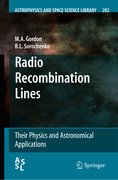
Radio recombination lines: their physics and astronomical applications
Gordon, M.
Sorochenko, R.
This book is a comprehensive guide to the physics and observations of Radio Recombination Lines from astronomical sources, written for astronomers, physicists, and graduate students. It is suitable for a graduate-level textbook. It includes the history of RRL detections, the astrophysics underlying their intensities and line shapes including topics like departures from LTE and Stark broadening, the maximum possible size of an atom, as well as detailed descriptions of the astronomical topics for which RRLs have proved to be effective tools.The text includes more than 250 equations and 110 illustrations. It also contains hundreds of specific references to the astronomical literature to enable readers to explore additional details. The appendix includes supplementary information such as the detailed physics underlying the Bohr atomic model, tablesof RRL frequencies including fine structure components, techniques for calculating hydrogenic oscillator strengths, FORTRAN code for calculating departure coefficients, and a discussion with formulas for converting observational (telescope) intensity units to astrophysical ones. INDICE: Preface.- Introduction.- RRLs and Atomic Physics.- RRLs: Tools forAstronomers.- RRLs from Extragalactic Objects.- Constants.- Tables of Line Frequencies.- Supplemental Calculations.- Hydrogen Oscillator Strengths.- Departure Coefficients.- Observational Units.- Author Index.- References. Index.
- ISBN: 978-0-387-09604-9
- Editorial: Springer
- Encuadernacion: Rústica
- Páginas: 375
- Fecha Publicación: 01/11/2008
- Nº Volúmenes: 1
- Idioma: Inglés
